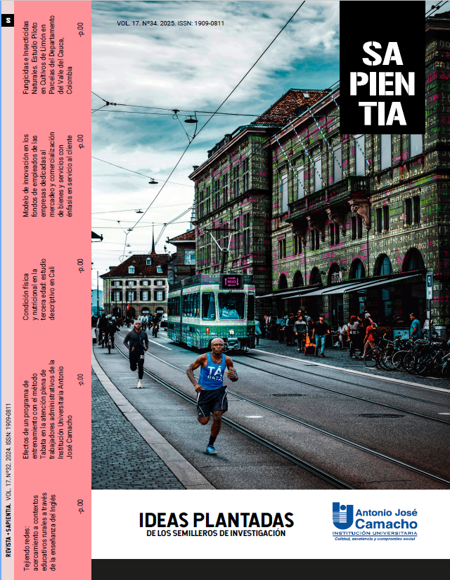Natural Fungicides and Insecticides.: Pilot Study in Lemon Crops in Valle del Cauca Departament Plots
Fungicidas e Insecticidas Naturales. Estudio Piloto en Cultivos de Limón en Parcelas del Departamento del Valle del Cauca, Colombia
Main Article Content
This project focused on assessing the effectiveness of a natural fungicide produced from garlic and aji on mushroom management in agriculture. The research was based on the collection of experience and practical observations. The results demonstrated the effectiveness of this natural fungicide, highlighting its antimicrobial properties. In addition, a reduced environmental impact was identified compared to the use of conventional chemical fungicides. These findings promote sustainable agricultural practices and provide a viable and environmentally friendly alternative to fungal control in agriculture.
Downloads
Article Details
Aguirre Yela, V. y Delgado, V.. (2010). Pesticidas Naturales yY Sinteticos. Revista Ciencia, 13(1), 43-53. https://www.academia.edu/7497645/PESTICIDAS_NATURALES_Y_SINTETICOS.
Al-Samarrai, G., Singh, H., & Syarhabil, M. (2012). Evaluating eco-friendly botanicals (natural plant extracts) as alternatives to synthetic fungicides. Annals of Agricultural and Environmental Medicine, 19(4), 673–676. http://www.aaem.pl/pdf-71842-9068?filename=Evaluating eco_friendly.pdf
Bayer Crop Science United States. (2025). Fungicide Modes of Action. https://www.cropscience.bayer.us/articles/bayer/fungicide-modes-action
Benelli, G., Canale, A., Toniolo, C., Higuchi, A., Murugan, K., Pavela, R., & Nicoletti, M. (2017). Neem (Azadirachta indica): towards the ideal insecticide? Natural Product Research, 31(4), 369–386. https://doi.org/10.1080/14786419.2016.1214834 DOI: https://doi.org/10.1080/14786419.2016.1214834
Cifuentes, G. (2006). Módulo Curso Fitopatología. Universidad Nacional Abierta y a Distancia UNAD. https://pdfcoke.com/documents/modulo-curso-fitopatologiapdf-d378w6450ezx
Gold, L.S., Slone, T.H., Ames, B.N., & Manley, N.B. (2001). CHAPTER 38 – Pesticide Residues in Food and Cancer Risk: A Critical Analysis. In Handbook of Pesticide Toxicology (pp. 799–843). Elsevier. https://doi.org/10.1016/B978-012426260-7.50041-0 DOI: https://doi.org/10.1016/B978-012426260-7/50041-0
Gupta, S., Dash, P. P., Mishra, A., & Gupta, R. K. (2024). Exploring the Efficacy and Sustainability of Natural Pesticides in Plant Protection. Current Functional Foods, 03(2). https://doi.org/10.2174/0126668629301079240816072818 DOI: https://doi.org/10.2174/0126668629301079240816072818
Hossain, L., Rahman, R., & Khan, M. S. (2017). Alternatives of Pesticides. Pesticide Residue in Foods: Sources, Management, and Control, 147–165. https://doi.org/10.1007/978-3-319-52683-6_9 DOI: https://doi.org/10.1007/978-3-319-52683-6_9
Juárez-Segovia, K.G., Díaz-Darcía, E.J., Méndez-López, M.D., Pina-Canseco, M.S., Pérez-Santiago, A.D., & Sánchez-Medina, M.A.. (2019). Efecto de extractos crudos de ajo (Allium sativum) sobre el desarrollo in vitro de Aspergillus parasiticus y Aspergillus niger. Polibotánica, (47), 99-111. https://doi.org/10.18387/polibotanica.47.8 DOI: https://doi.org/10.18387/polibotanica.47.8
Martìn J, Lenis L., Orozco M, Solarte C. (2006). Extracción de pigmento del fruto del ají (Capsicum spp.) y cuantificación de los carotenoides mayoritarios capsantina y capsorubina. El hombre y la máquina, 27, 94-99. http://red.uao.edu.co:8080/bitstream/10614/154/1/T0003242.pdf
Ngegba, P. M., Cui, G., Khalid, M. Z., & Zhong, G. (2022). Use of Botanical Pesticides in Agriculture as an Alternative to Synthetic Pesticides. Agriculture (Switzerland), 12(5). https://doi.org/10.3390/AGRICULTURE12050600 DOI: https://doi.org/10.3390/agriculture12050600
Rojas Restrepo, J. (2015). Fertilidad de suelos en plantaciones forestales del trópico colombiano (Tesis de maestría). Universidad Nacional Abierta y a Distancia. https://repositorio.unal.edu.co/handle/unal/55674
Sánchez-Bayo, F., Goulson, D., Pennacchio, F., Nazzi, F., Goka, K., & Desneux, N. (2016). Are bee diseases linked to pesticides? - A brief review. Environment international, 89-90, 7–11. https://doi.org/10.1016/j.envint.2016.01.009 DOI: https://doi.org/10.1016/j.envint.2016.01.009



 Perfil Google Scholar
Perfil Google Scholar







